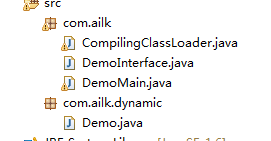动态重新加载Class机制之代码测试
V1.1修改了主程序,调用带参数的构造函数
package com.ailk;
import java.lang.reflect.*;
import java.util.ArrayList;
import java.util.List;
import com.ailk.dynamic.Demo;
public class DemoMain {
static public void main( String args[] ) throws Exception {
String progClass ="com.ailk.dynamic.Demo";
// 创建CompilingClassLoader
Class c = Class.forName(progClass, true, new CompilingClassLoader());
//DemoInterface i=(DemoInterface)c.newInstance();
//cl1和cl2是两个不同的ClassLoader
ClassLoader cl1=c.getClassLoader();
ClassLoader cl2=Demo.class.getClassLoader();
ClassLoader cl3=DemoInterface.class.getClassLoader();
int ii=0;
List<DemoInterface> objList=new ArrayList();
while(true){
ii++;
CompilingClassLoader ccl = new CompilingClassLoader();
// 通过CCL加载主函数类。
Class clas = ccl.loadClass( progClass,true);
try{
Constructor c1=c.getDeclaredConstructor(new Class[]{String.class});
c1.setAccessible(true);
DemoInterface a1=(DemoInterface)c1.newInstance(new Object[]{"Demo"});
}catch(NoSuchMethodException e){
System.out.println("构造函数不存在");
e.printStackTrace();
}
DemoInterface instance=null;
try{
Constructor c0=clas.getDeclaredConstructor();
c0.setAccessible(true);
instance=(DemoInterface)c0.newInstance();
}catch(NoSuchMethodException e){
System.out.println("构造函数不存在");
e.printStackTrace();
}
ccl=null;//这里讲主动释放cc1
//DemoInterface instance=(DemoInterface)clas.newInstance();
if (instance!=null)
{
objList.add(instance);
instance.print("demo");
// 利用反射调用它的函数和传递参数。
// 产生一个代表主函数的参数类型的类对象。
Class mainArgType[] = { String.class };
//在类中找函数。
Method method = clas.getMethod( "print", mainArgType );
Object[] argsArray={"Demo"};
//调用方法。
method.invoke(instance, argsArray );
}
if (ii>20)
{
ii=0;
objList.clear();
}
Thread.sleep(500);
//强制gc,只有objList清空后 CompilingClassLoader的实例才会释放。
//因为只有由CompilingClassLoader载入的class的实例全部释放后,CompilingClassLoader才能被释放
System.gc();
}
}
}V1.0
在运行过程住动态编译并重新加载Class需要继承ClassLoader ,没有不同的CompilingClassLoader加载的class是不相同的不能相互转换。对于CompilingClassLoader 的实例,只是简单的赋null是会自动释放的,只有由其载入的class的全部实例都释放后,CompilingClassLoader 的实例才会释放。我在代码里加入了protected void finalize()来检测实例何时释放。

在reload/com/ailk/dynamic中放一个要动态重载的Java程序,这里我们把测试类放这个目录。代理类package com.ailk;
public interface DemoInterface {
public void print( String args);
}
public interface DemoInterface {
public void print( String args);
}
测试类package com.ailk.dynamic;
import com.ailk.DemoInterface;
public class Demo implements DemoInterface {
@Override
public void print( String args){
}
}
import com.ailk.DemoInterface;
public class Demo implements DemoInterface {
@Override
public void print( String args){
}
}
主程序package com.ailk;
import java.lang.reflect.*;
import java.util.ArrayList;
import java.util.List;
import com.ailk.dynamic.Demo;
public class DemoMain {
static public void main( String args[] ) throws Exception {
String progClass ="com.ailk.dynamic.Demo";
// 创建CompilingClassLoader
Class c = Class.forName(progClass, true, new CompilingClassLoader());
DemoInterface i=(DemoInterface)c.newInstance();
//cl1和cl2是两个不同的ClassLoader
ClassLoader cl1=c.getClassLoader();
ClassLoader cl2=Demo.class.getClassLoader();
ClassLoader cl3=DemoInterface.class.getClassLoader();
int ii=0;
List<DemoInterface> objList=new ArrayList();
while(true){
ii++;
CompilingClassLoader ccl = new CompilingClassLoader();
// 通过CCL加载主函数类。
Class clas = ccl.loadClass( progClass,true);
// 利用反射调用它的函数和传递参数。
// 产生一个代表主函数的参数类型的类对象。
Class mainArgType[] = { String.class };
// 在类中找函数。
Method method = clas.getMethod( "print", mainArgType );
Object[] argsArray={"Demo"};
//调用方法。
method.invoke( clas.newInstance(), argsArray );
ccl=null;//这里讲主动释放cc1
DemoInterface instance=(DemoInterface)clas.newInstance();
objList.add(instance);
instance.print("demo");
if (ii>20)
{
ii=0;
objList.clear();
}
Thread.sleep(500);
//强制gc,只有objList清空后 CompilingClassLoader的实例才会释放。
//因为只有由CompilingClassLoader载入的class的实例全部释放后,CompilingClassLoader才能被释放
System.gc();
}
}
}
import java.lang.reflect.*;
import java.util.ArrayList;
import java.util.List;
import com.ailk.dynamic.Demo;
public class DemoMain {
static public void main( String args[] ) throws Exception {
String progClass ="com.ailk.dynamic.Demo";
// 创建CompilingClassLoader
Class c = Class.forName(progClass, true, new CompilingClassLoader());
DemoInterface i=(DemoInterface)c.newInstance();
//cl1和cl2是两个不同的ClassLoader
ClassLoader cl1=c.getClassLoader();
ClassLoader cl2=Demo.class.getClassLoader();
ClassLoader cl3=DemoInterface.class.getClassLoader();
int ii=0;
List<DemoInterface> objList=new ArrayList();
while(true){
ii++;
CompilingClassLoader ccl = new CompilingClassLoader();
// 通过CCL加载主函数类。
Class clas = ccl.loadClass( progClass,true);
// 利用反射调用它的函数和传递参数。
// 产生一个代表主函数的参数类型的类对象。
Class mainArgType[] = { String.class };
// 在类中找函数。
Method method = clas.getMethod( "print", mainArgType );
Object[] argsArray={"Demo"};
//调用方法。
method.invoke( clas.newInstance(), argsArray );
ccl=null;//这里讲主动释放cc1
DemoInterface instance=(DemoInterface)clas.newInstance();
objList.add(instance);
instance.print("demo");
if (ii>20)
{
ii=0;
objList.clear();
}
Thread.sleep(500);
//强制gc,只有objList清空后 CompilingClassLoader的实例才会释放。
//因为只有由CompilingClassLoader载入的class的实例全部释放后,CompilingClassLoader才能被释放
System.gc();
}
}
}
下面的这个类就是我们自己的一个CompilingClassLoader 。其功能是从当前类的路径中的目录的reload中加载class文件,如果其Java文件有更新则重新编译然后再加载,注意,在reload的目录中只放如需要重新加载的类,其他的不要放到这个目录中,特别是代理接口。如果代理接口也放到这个目录中的相应的目录下的话,CompilingClassLoader 就会将其加载,那么 我们在main程序的DemoInterface instance=(DemoInterface)clas.newInstance()行就会发生java.lang.ClassCastException 错误。
package com.ailk;
import java.io.*;
/*
CompilingClassLoader动态的编译Java源文件。它检查.class文件是否存在,.class文件是
否比源文件陈旧。
*/
public class CompilingClassLoader extends ClassLoader {
protected void finalize()
{
System.out.println("finalize this:"+this);
try {
super.finalize();
} catch (Throwable e) {
// TODO Auto-generated catch block
e.printStackTrace();
}
}
// 指定一个文件名,从磁盘读取整个文件内容,返回字节数组。
private byte[] getBytes(String filename) throws IOException {
// 获得文件大小。
File file = new File(filename);
long len = file.length();
// 创建一个数组刚好可以存放文件的内容。
byte raw[] = new byte[(int) len];
// 打开文件
FileInputStream fin = new FileInputStream(file);
// 读取所有内容,如果没法读取,表示发生了一个错误。
int r = fin.read(raw);
if (r != len)
throw new IOException("Can't read all, " + r + " != " + len);
// 别忘了关闭文件。
fin.close();
// 返回这个数组。
return raw;
}
// 产生一个进程来编译指定的Java源文件,制定文件参数.如果编译成功返回true,否者,
// 返回false。
private boolean compile(String javaFile) throws IOException {
// 显示当前进度
System.out.println("CCL: Compiling " + javaFile + "...");
// 启动编译器
Process p = Runtime.getRuntime().exec(
"javac -classpath " + CompilingClassLoader.class.getResource("/").getPath()
+ " -Xlint:unchecked " + javaFile);
// 等待编译结束
try {
p.waitFor();
} catch (InterruptedException ie) {
System.out.println(ie);
}
// 检查返回码,看编译是否出错。
int ret = p.exitValue();
// 返回编译是否成功。
return ret == 0;
}
// 类加载器的核心代码 -加载类在需要的时候自动编译源文件。
public Class loadClass(String name, boolean resolve)
throws ClassNotFoundException {
// if (!name.startsWith("com.ailk.dynamic")){
// return getParent().loadClass(name);
// }
// 我们的目的是获得一个类对象。
Class clas = null;
// 首先,检查是否已经出理过这个类。
clas = findLoadedClass(name);
if (clas != null)
return clas;
// if (clas == null) {
// try {
// if (getParent() != null) {
// clas = super.findClass(name);
// } else {
// clas = findSystemClass(name);
// }
// } catch (ClassNotFoundException e) {
// // If still not found, then invoke findClass in order
// // to find the class.
// //clas = findClass(name);
// }
// }
// System.out.println( "findLoadedClass: "+clas );
// 通过类名获得路径名 比如:java.lang.Object => java/lang/Object
String fileStub = name.replace('.', '/');
// 构建指向源文件和类文件的对象。
String javaFilename = CompilingClassLoader.class.getResource("/").getPath() + "reload/"
+ fileStub + ".java";
//System.out.println(javaFilename);
String classFilename = CompilingClassLoader.class.getResource("/").getPath() + "reload/"
+ fileStub + ".class";
//System.out.println(classFilename);
File javaFile = new File(javaFilename);
File classFile = new File(classFilename);
// System.out.println( "j "+javaFile.lastModified()+" c "
// +classFile.lastModified() );
// 首先,判断是否需要编译。如果源文件存在而类文件不存在,或者都存在,但是源文件
// 较新,说明需要编译。
boolean javaExists = javaFile.exists();
boolean classExists = classFile.exists();
if (javaFile.exists()
&& (!classFile.exists() || javaFile.lastModified() > classFile
.lastModified())) {
try {
// 编译,如果编译失败,我们必须声明失败原因(仅仅使用陈旧的类是不够的)。
if (!compile(javaFilename) || !classFile.exists()) {
throw new ClassNotFoundException("Compile failed: "
+ javaFilename);
}
} catch (IOException ie) {
// 可能编译时出现IO错误。
throw new ClassNotFoundException(ie.toString());
}
}
// 确保已经正确编译或者不需要编译,我们开始加载原始字节。
try {
// 读取字节。
byte raw[] = getBytes(classFilename);
// 转化为类对象
clas = defineClass(name, raw, 0, raw.length);
System.out.println("load class:"+classFilename+" classloader is:"+this);
} catch (IOException ie) {
// 这里并不表示失败,可能我们处理的类在本地类库中,如java.lang.Object。
}
// System.out.println( "defineClass: "+clas );
// 可能在类库中,以默认的方式加载。
if (clas == null) {
clas = findSystemClass(name);
//System.out.println("use define class:"+name);
}
// System.out.println( "findSystemClass: "+clas );
// 如果参数resolve为true,根据需要解释类。
if (resolve && clas != null)
resolveClass(clas);
// 如果还没有获得类,说明出错了。
if (clas == null)
throw new ClassNotFoundException(name);
// 否则,返回这个类对象。
return clas;
}
}







